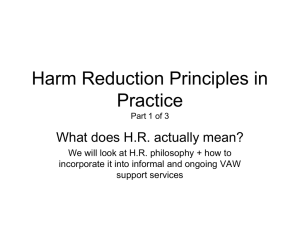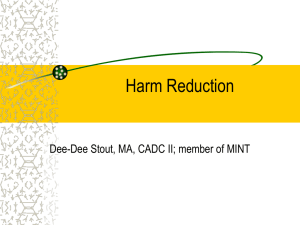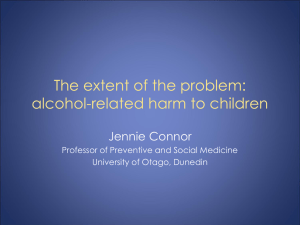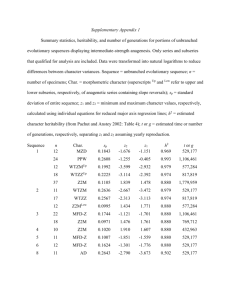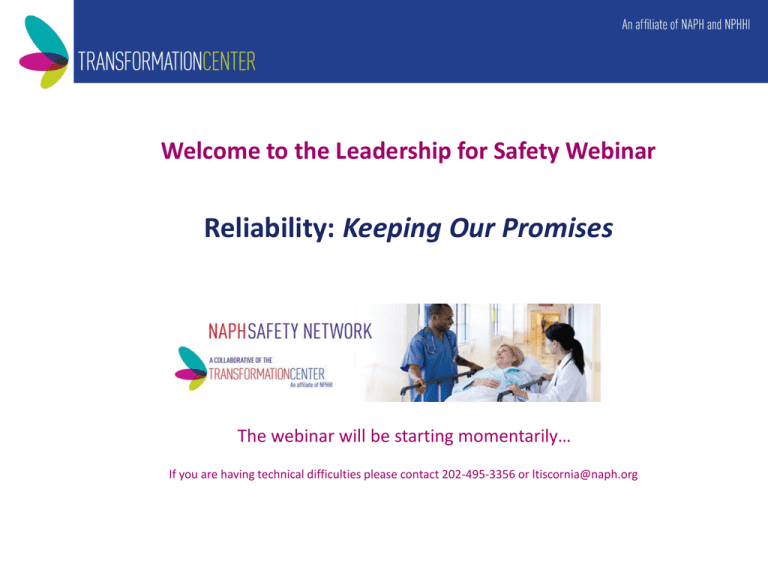
Welcome to the Leadership for Safety Webinar
Reliability: Keeping Our Promises
The webinar will be starting momentarily…
If you are having technical difficulties please contact 202-495-3356 or ltiscornia@naph.org
Chat Box
Please use the Chat Box on the webinar
screen to type your question or
comment at any time.
NOW: Use the Chat Box to sign in.
1) Enter your organization and names of
all people in the room.
2) Send to “HOST”
3) Click “SEND”
Starting at the Beginning:
Two Promises We Make to Our Patients
We will do everything that we
know will help.
We will do nothing that will harm.
3
Copyright, The Reinertsen Group
How well do we keep our
promises?
• Help:
–55%
–10-1
• Harm:
–1%
–14.6%
–200,000 +
4
How Hazardous Is Health Care?
(Leape)
DANGEROUS
(>1/1000)
100,000
REGULATED
ULTRA-SAFE
(<1/100K)
HealthCare
Total lives lost per year
Driving
10,000
1,000
Scheduled
Airlines
100
Mountain
Climbing
Bungee
Jumping
10
Chemical
Manufacturing
Chartered
Flights
European
Railroads
Nuclear
Power
1
1
10
100
1,000
10,000
100,000
Number of encounters for each fatality
1,000,000 10,000,000
Are we seeing all the harm? Inpatient Surgical Record
Review of 854 patients in 11 US hospitals…
• Found 14.6% of patients had a Surgical
Adverse Event (SAE)
• 44% of SAEs caused increase LOS or
readmit
• 8.7% required life-saving intervention or
resulted in permanent harm or death
• “…Most of the events identified by Trigger
Tool review had not been detected or
reported via any other existing
mechanism.”
6
References
• McGlynn EA, SM Asch, J Adams, J Keesey, J Hicks, A
DeCristofaro, EA Kerr: The Quality of Health Care
Delivered to Adults in the United States. New England
Journal of Medicine 2003, 348: 2635-2645
• Zhan C, Miller MR. Excess length of stay, charges, and
mortality attributable to medical injuries during
hospitalization. JAMA. 2003;290:1868-1874
• Amalberti R, Y Auroy, D Berwick, P Barach. Five System
Barriers to Achieving Ultrasafe Health Care Ann. Int. Med.
2005; 142: 756-764
• Griffin, FA and DC Classen. Detection of adverse events in
surgical patients using the trigger tool approach. Qual. Saf.
Health Care 2008; 17: 252-8
7
Reliability:
Defect-free operation, over time,
regardless of…
8
How Reliable is Health Care? (Amalberti, Nolan)
Chaos
Processes are
largely
custom-crafted
each time
10-1
Standard
specs,
training,
trying hard
10-2
Standard
process;
redundancy,
habits and
patterns…
10-3 , 10-4
10-5
HRO culture;
Loss of
Obsession with identity
Each doctor
writes
individual
orders, gives
to RN
5 people
describe 5
processes;
feedback on
compliance
5 people
describe 1
process;
multi-disc.
rounds
External
approval
necessary
for certain
orders
Equivalent
actor
Preventing,
treating acute
and chronic
disease in US
Surgical
checklists
and harm
Best
hospitals
Core
Measures
ADEs per
1000 doses,
blood
banking
Safety in
anesthesia
failure,
deference to
expertise…
Let’s talk about the
catastrophic processes—the
right side of this table.
Could we do better than this?
10
What is possible in safety? Commercial Aviation
11
Scrams per 7,000 hours
Unplanned Automatic SCRAM
Rate – US Nuclear Power Plants
Year
The unplanned automatic scrams per 7,000 hrs critical indicator tracks the median scram (automatic shutdown) rate
for approximately one year (7,000 hrs) of operation. Unplanned automatic scrams result in thermal and hydraulic
transients that affect plant systems. The scram rate has been significantly reduced since 1980. In 2000, 59% of
operating plants had zero automatic scrams.
Source: Statistics Show US Nuclear Power Plants Always Improving, Nuclear News, May 2001
12
Class A Mishaps/100,000 Flight Hours
Naval Aviation Mishap Rate
60
776 aircraft
destroyed in
1954
Angled Carrier Decks
Naval Aviation Safety Center
50
NAMP est. 1959
15 aircraft
destroyed in
2008
RAG concept initiated
40
NATOPS initiated 1961
Squadron Safety program
30
System Safety
Designated Aircraft
20
ACT
10
HFC’s
1.64
0
50
65
Fiscal Year
80
08
Source: www.safetycenter.navy/mil ORM Flight Mishap Rate
13
US Nuclear Powered Submarines
5,500 cumulative years of nuclear
reactor ops
127 million miles submerged
(264 round trips to moon)
Operated by 20 year olds
Zero reactor accidents
14
Highly Reliable
Organizations (HROs)
“operate under very
trying conditions all
the time and yet
manage to have fewer
than their fair share of
accidents.”
15
Copyright 2006 Healthcare Performance Improvement, LLC.
ALL RIGHTS RESERVED.
How do they do that?
16
Culture and Structure:
hierarchy, transparency,
safety rules, accountability…
Technology and
Environment: error
proofing,
distractions…
Processes: workflow
scheduling,
complexity…
Harm
Human error
(slip, lapse,
reliance on
memory,
confirmation
bias…)
The Swiss Cheese Model
17
Adapted from James Reason Managing the Risk of
Organizational Accidents 1997
Culture: error has
Nurse doesn’t check
happened before; no
dose closely in rush to
one questions 1200 mg get all QD doses in at 8
in IV bag rather than
am
irrigation
Rx Computer system
accepts “1200 mg IV”
Renal
failure,
death
Pharmacist
clicks 1200
rather than
120 mg on
computer
picklist
1200 mg Tobramycin IV
18
Errors, Harm, Negligence, and Intent
Errors
Skill based
Rule based
Knowledge based
Harm
Negligence,
Reckless
Disregard
19
Intent
2. Work as leaders
to detect and plug
the holes in
processes,
structures,
cultures, and
technologies
Harm
1. Accept that
human error will
occur. Use
human factors
engineering to
reduce the
likelihood of it,
and develop a
culture of
accountability
Two Key Approaches to Higher Levels of
Reliability for “Immediately
Catastrophic” Processes
20
Working both the Sharp End and the Blunt End
#1
Reduce likelihood of
individual behavior
failures
•Competency
•Consciousness
•Communication
•Compliance
•Critical thinking
#2
Find and Fix
system “latent
errors”
•Structure
•Culture
•Policy/protocol
•Process
•Technology &
environment
Adapted from Kerry Johnson, HPIpyance.
21
Reducing the likelihood of
skill-based (automatic) errors
─Fatigue: work schedules
─Distractions: “do not disturb”
─Error-proofing, design: Separating IV
and topical dose forms in computer
─Visual signals
Stop, Think, Act and Review
22
Reducing the likelihood of
rules-based errors
• Make it easy to comply with the rule
• Increase the perception of “likelihood
of being observed” while carrying out
the rule
• Increase the perception of the risk of
non-compliance
23
Establish Accountability
Accountability
from Self
Accountability
from Peers
Optimal
Accountability
Accountability
from Leaders
Healthcare Performance
Improvement
24
How Reliable is Health Care? (Amalberti, Nolan)
Chaos
Processes are
largely
custom-crafted
each time
10-1
Standard
specs,
training,
trying hard
10-2
Standard
process;
redundancy,
habits and
patterns…
Each doctor
writes
individual
orders, gives
to RN
5 people
describe 5
processes;
feedback on
compliance
5 people
describe 1
process;
multi-disc.
rounds
Preventing,
treating acute
and chronic
disease in US
Surgical
checklists
and harm
Best
hospitals
Core
Measures
10-3 , 10-4
10-5
HRO culture;
Loss of
Obsession with identity
failure,
deference to
expertise…
Let’s look
at the left
External
Equivalent
side ofactor
this
approval
necessary
table
for certain
orders
ADEs per
1000 doses,
blood
banking
Safety in
anesthesia
25
Discussion for NAPH Leaders
• Describe the reliability of a safety process
your teams are currently working to
improve. Where does that process fall on
the reliability grid?
• What are your current ideas for making the
process more reliable?
• What is your aim: how reliable are you
trying to become?
26
Why do we get “stuck” at low levels
of reliability?
• We tend to rely on vigilance and hard
work
• We focus on outcomes rather than
process
• We fail to design and implement
standard work
• We don’t understand and use
sophisticated designs for reliability
27
Improvement Concepts Associated with 10-1 Performance
•
•
•
•
•
•
•
Common equipment
Standard order sets
Care protocols and pathways
Written policies/procedures
Personal check lists
Feedback of information on compliance
Suggestions to work harder, pay closer
attention… next time
28
• Awareness and training
Improvement Concepts Associated with
10-2 Performance
• Build decision aids and reminders into the
system
• Make the desired action the default
• Redundancy
• Scheduling
• Take advantage of existing habits and
patterns of work
• Standardize who, where, when…not just
what (Standard work, not standard specs)
29
Examples of Level 2 Concepts
for CHF or CAP
• Decision aids or reminders in real time:
– Standing order set is placed on front of chart
when decision to admit is made
• Desired action the default:
– All patients with diagnosis of pneumonia will
get pneumovax by nurse, with or without
specific order
• Redundancy:
– Multidisciplinary rounds on every patient daily
– Home visit to check on meds after 48 hours
30
Examples of Level 2 Concepts
for CHF or CAP (2)
• Scheduling:
– Make a discharge appointment for all patients
at least 24 hours prior to discharge
• Smooths nursing workflow
• Starts process of discharge instructions well in
advance
• Engages family members in planning
• Take advantage of existing habits and
patterns
– Visual cue to “start pre-op antibiotics” based
31
on measured flow of pre-op work
Example of Level 2 Concepts
• Bundles
–clusters of evidence based services
in space and time, treated as “all or
none” e.g. “sterile technique in the
OR”, ventilator bundle…
32
Key Learning Points for Leaders
• Hard work and vigilance alone will
condemn the team to 10-1 performance
at best
• If 10-2 change concepts do not make
up at least 25% of the improvement
effort on a given project require the
team to rethink the design
33
Why is health care so unreliable?
• We tend to rely on vigilance and hard
work
• Greater focus on outcomes than
process
• We fail to design and implement
standard work
• We don’t understand and use
sophisticated designs for reliability
34
Outcomes versus Process
• Biology protects us: each process defect
doesn’t necessarily lead to a bad outcome
e.g. hand-washing
• Systems protect us…except when they don’t
e.g. 1200 mg tobramycin i.v.
• Benchmarks reassure us…e.g. “2.0 BSI’s per
1000 line hours is better than the benchmark
35
so our processes must be OK”
Why is health care so unreliable?
• We tend to rely on vigilance and hard
work
• We focus on outcomes rather than
process
• We fail to design and implement
standard work
• We don’t understand and use
sophisticated designs for reliability
36
Level 2 Concept: Standard Work
Is this what you mean by standardization?
• Months of meetings designing a care pathway,
standing order set, protocol…
• Focus is on WHAT should be done (not HOW).
• 10,000 copies of the final version are printed up.
• Changes to the final version are discouraged.
• Physicians are encouraged to “opt in”.
• Even though the protocol or order set has never
been tested in the field
37
Design
Design
Design
Design
Approve
Conference Rooms
Real World
Implement
38
A Better Way to Standardize
• Spend no more than one meeting on “what”.
• Start testing one way to do the “what” in the
field, on a small scale.
• Encourage many rapid tests of change in
how, when, where, who…and in the what, if
necessary…to make the standard way work
well for 90% of doctors and nurses.
• Once you’ve got it right, expect all the
doctors and nurses to use it (opt out if you
have to, not “please opt in”).
39
Conference Rooms
Approve
(if necessary)
Design
Test and
Modify
Test and
Modify
Test and
Modify
Implement
Real World
40
“Practice the science of
medicine as a team, and the
art of medicine as individuals.”
41
OK…But what do Leaders do?
•
•
•
•
Choose the outcomes that you want to achieve
Hypothesize: process and outcome
Set reasonable timelines
Expect teams to
– Achieve process reliability at 95%
– Use good design principles, not just vigilance and hard
work
– Test designs frequently, on small scale, not in one big
spasm
• If the process gets to 95% and the outcome
doesn’t improve…
– Check the data on the process
– Revise your theory
42
A Key Question Leaders Should Ask
Is there a logical, evidence-based
connection between the process the
team is trying to improve, and the
outcome you wish to achieve?
43
Is this a good plan to reduce injuries
from falls?
Outcome
Goal
Decrease
Falls
44
Key Drivers
Processes
Reliable risk Red booties
assessment for at risk
of patients for patients
falls
The Fact
There is no good medical
evidence that risk assessment
actually reduces falls!
45
Evidence-Based Thinking!
Outcome
Goals
Decrease
Falls
46
Key Drivers
Toileting in
at risk
patients
Processes
Every 2
hour
toileting
rounds on at
risk patients
Summary: To become more reliable for
non-catastrophic processes…
•
•
•
Choose a process that has a high likelihood
of affecting the outcome of interest
Set an aim for 10-2 reliability of the process
Move toward that aim in three steps:
1. Segment and standardize to get the basic
process to solid 10-1 using Level I and Level II
concepts
2. Identify remaining defects and mitigate them in
real time to get to 10-2
3. Redesign the process to reduce likelihood of
defects
47
Where to read more….
• http://www.ihi.org/IHI/Topics/Reliability/
48
Next Month:
Thursday, May 23 9am PT/10am MT/11am CT/ 12am ET
When Things Go Really Wrong: Responding to Organizational Crises
With special guest speaker Jim Conway!
Assignment:
• Find out if your organization has a crisis management plan for safety disasters.
Then ask:
• What is the plan for notifying the board? Which board members? When? By whom?
• Who will speak for the organization? Who is to speak to family members?
• What training is in place?
Be prepared to discuss your plans on the webinar.
49
SAVE THE DATE!
Leadership for Safety: Yes, It’s Personal
A Workshop for Boards, C-Suite, and Senior Leaders
June 19, 2013
8:00am – 5:00pm
Westin Diplomat Resort in Hollywood, FL
50
THANK YOU FOR JOINING US
Feedback survey can be accessed in chat box.
51



